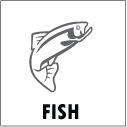
Bass, Flounder, Cod – Entire families of Fish
- 50% of fish-allergic suffer allergy to one or more fish (high cross-reactivity).
- Fish allergy is most often a life-long allergy and rarely resolves during puberty.
- Offending proteins are Myosin (muscle) – it is why saltwater and freshwater fish cross-react.
- Fish oil supplements can contain enough protein to trigger an allergic reaction.
Relevance to Food Service
- Fish can appear unexpectedly in bottled sauces, marinades and dressing as it lends an Umami flavor.
- Fish proteins can be aeroallergens and so the aromas and steam from cooking can provoke anaphylaxis.
- Fish can be a potent contact allergen – complete and thorough cleaning of utensils and surfaces is critical.
Dietary Labeling for Fish
Anchovies
Barramundi
Bass
Bluefish
Bream
Carp
Catfish
Caviar
Char
Chub
Cisco
Cod
Eel
Fish
Flathead
Dietary Labeling for Fish
Flounder
Grouper
Haddock
Hake
Halibut
Herring
Mackerel
Mahimahi
Marlin
Monkfish
Orange Roughy
Pangasius
Perch
Pickerel
Pike
Pollock
Roe
Salmon
Scrod
Snapper
Sole
Surimi
Swordfish
Tilapia
Trout
Tuna
Worcestershire sauce (anchovies)
May contain Fish
Antipasto
Asian dishes
Caesar salad
Canned spreads
Dips
Fish Flake
Fish sauce
Fish stock
Gelatin
Greek dishes
Imitation crab
Marshmallow
Pizza toppings
Salad dressings
Soups
Surimi
Sushi
Fish – What’s the Allergen?
The primary allergens in fish are proteins, including parvalbumins, tropomyosins, and vitellins.
Parvalbumins are heat-stable, acidic proteins that are found in the muscle tissue of fish and are thought to play a role in muscle contraction. They are commonly recognized as allergens and can cause an allergic reaction in some individuals.
Tropomyosin is another allergenic protein that is found in the muscle tissue of fish and is structurally similar to tropomyosin found in shellfish. It is thought that this structural similarity can lead to cross-reactivity between fish and shellfish allergens.
Vitellins are lipid-binding proteins that are found in the eggs of fish and other animals. They can cause an allergic reaction in some individuals, but are less commonly recognized as allergens compared to parvalbumins and tropomyosin.
Fish allergens are typically found in the flesh and sometimes in the roe (eggs) and other internal organs.
Cod
The Gadidae family of fish includes several species of saltwater fish that are commonly referred to as “cod.” Members of the Gadidae family include:
Atlantic cod (Gadus morhua)
Pacific cod (Gadus macrocephalus)
Greenland cod (Gadus ogac)
Skeleton cod (Gadus nasi)
Haddock (Melanogrammus aeglefinus)
Whiting (Merlangius merlangus)
Saithe (Pollachius virens)
Pollock (Pollachius pollachius)
Hake (Urophycis spp.)
These species are characterized by their white flesh and firm texture, and are widely consumed as food around the world. Some of these species, such as Atlantic cod and Pacific cod, are also economically important and are widely farmed and traded in the global seafood market.
Cod and other members of the Gadidae family are important sources of food for humans, and they are widely consumed both fresh and in various processed forms, such as frozen fillets, dried and salted fish, and fish cakes.
Gadidae fish are found in cold waters of the northern hemisphere, including the Atlantic and Pacific Oceans, and they play an important role in many marine ecosystems. They are typically bottom-dwelling fish that feed on smaller fish and invertebrates.
The allergenic components in Gadidae fish, including Atlantic cod, Pacific cod, haddock, pollock, and whiting, are similar to those found in other types of seafood.
Bass
The bass family of fish, also known as the Moronidae family, includes several species of freshwater and saltwater fish that are popular among recreational and commercial fishers. Members of the bass family include:
Striped bass (Morone saxatilis)
White bass (Morone chrysops)
Yellow bass (Morone mississippiensis)
Hybrid striped bass (Morone hybrid)
European sea bass (Dicentrarchus labrax)
Barramundi (Lates calcarifer)
Groupers (Epinephelus spp.)
Jiolin (Percichthys spp.)
These species are characterized by their predatory habits and their often large size, and are widely sought after for their delicious flesh. Some species, such as the striped bass, white bass, and yellow bass, are popular sportfish in North America and are widely stocked in lakes and rivers for recreational fishing. Other species, such as the European sea bass and barramundi, are economically important and are widely farmed for their edible flesh.
Flounder
The flounder family of fish, scientifically known as the Pleuronectidae family, includes many species of flatfish that are popular among recreational and commercial fishers. Some of the species included in the Pleuronectidae family are:
Summer flounder (Paralichthys dentatus)
Winter flounder (Pseudopleuronectes americanus)
Yellowtail flounder (Limanda ferruginea)
Pacific halibut (Hippoglossus stenolepis)
European plaice (Pleuronectes platessa)
Dover sole (Solea solea)
Turbot (Scophthalmus maximus)
Sole (Soleidae spp.)
These species are characterized by their flat shape and bottom-dwelling habits, and are widely sought after for their delicious flesh. Some species, such as the summer flounder and the winter flounder, are economically important and are widely farmed for their edible flesh. Other species, such as the Pacific halibut and the European plaice, are popular among recreational and commercial fishers for their size and delicious flesh.